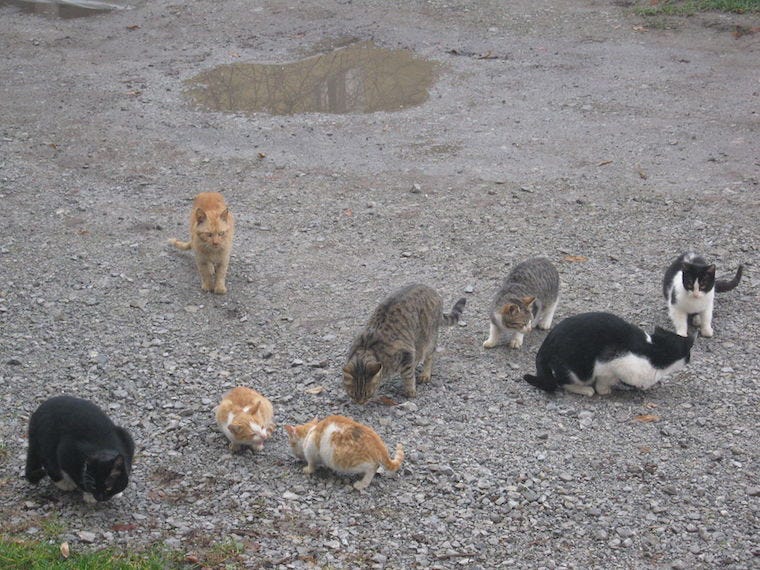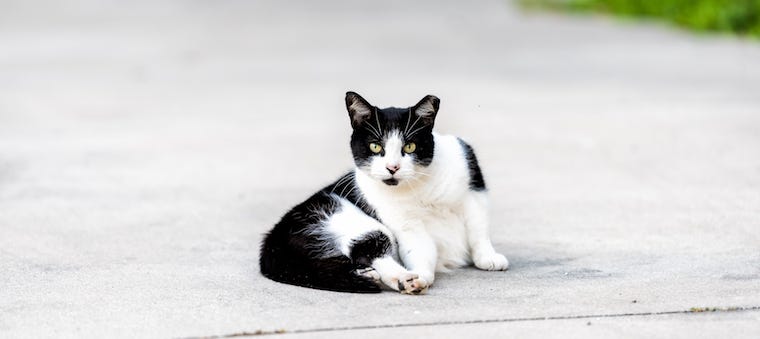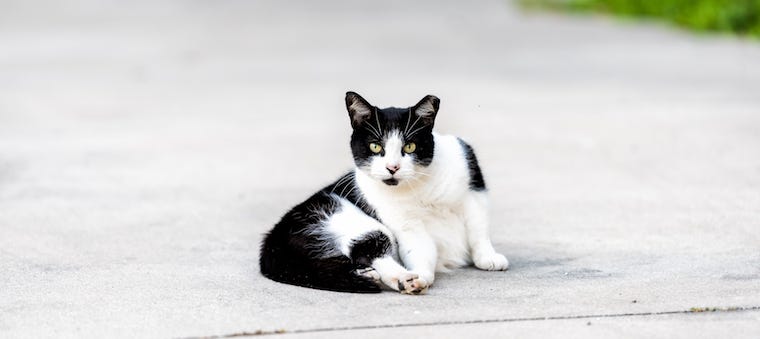Have you ever noticed a cat whose ear looks like it was snipped at the tip? While scary visions of scissors and evil neighborhood kids might flash through your mind, you can (usually) rest assured that what you’re seeing is the result of a perfectly safe practice called cat ear-tipping. Ear-tipping is the universal way to identify TNR cats (Trap-Neuter-Return)—and TNR is an essential method of curbing feline overpopulation.
Why practice TNR?
The purpose of TNR is to humanely control the population of feral cats, or what we more positively refer to as “community cat colonies.” These cats have either been born and raised in the wild, or joined a wild cat colony after being abandoned or lost.
Most community cats are fearful of human contact and do not tolerate being handled. While it is a hard life, they live and thrive outdoors, and are content to remain wild and part of their colony; they are past the point of being able to be socialized enough to be someone’s pet.
These felines are not a lost cause, however. By practicing TNR, we can promote healthier cat colonies while helping to curb the birth rates of kittens.

The basics of TNR
Whether you’re trapping one neighborhood tomcat or setting out to trap as many in a colony as possible, it’s important to be educated and prepared. Alley Cat Allies—an organization working to save ferals, strays, and kittens—provides a valuable step-by-step document detailing best practices of Trap-Neuter-Return. We’ve covered the basics below.
Trap
Prep work:
- Pick up a humane box trap or drop trap—never use darts or tranquilizers to trap a cat. Practice ahead of time how to set and bait traps.
- Attempt to contact or communicate with any caregivers of the colony (a kind neighbor putting out food, for instance). Tell them about your plans to TNR, and enlist their help if possible.
- Determine if the cats are stray or feral: Stray cats are more friendly toward people and feral cats are more wary of people. This will help you determine whether the cats should be returned after being neutered, or if they are candidates for socialization and eventual adoption. (Learn more about the difference between a stray cat and a feral cat.)
- To get the cats used to coming out and eating while you are there (and help with your assessment process), establish a set time and place to feed the cats every day. Feed out of unset traps for 1-2 weeks prior to the trapping day, to get cats used to seeing and walking into them. Do not put food anywhere else but inside the trap.
- Find and coordinate with a veterinarian or neuter clinic with feral cat experience. Check their prices for spaying and neutering, vaccines, and all other treatments.
- Set up a holding/recovery area for use before and after the cats’ surgeries. This should be a quiet, indoor, dry, and temperature-controlled room.
- Assemble a trapping kit that includes the trap, bait (canned cat food, etc.), newspaper, trap labels, trap covers, thick gloves, and more.
Day-of:
- 24 hours before trapping, withhold food at the trapping site, but always continue to provide water.
- Bait traps: Place about one tablespoon of bait at the very back of the trap, so that the cat will step on the trigger plate while attempting to reach the food. Also place a tiny bit of food (¼ teaspoon) just inside the entrance of the trap to encourage the cat to walk in.
- At the colony site, place traps on level ground—the cats will not enter an unstable or wobbly trap.
- Set the trap and move away from the area. Observe from a location far enough away that the cats will not be disturbed, but close enough so you can still see all the traps.

After you’ve trapped:
- Apply trap covers, such as towels, blankets, or sheets.
- Do not open the traps or release cats once trapped—even if it appears that the cats are hurting themselves. Remember, community cats may thrash around and try to escape, or simply shut down upon being trapped.
- Never attempt to pick up or handle a conscious community cat, even a kitten. Why? You risk injury to yourself or the cat—and if you’re bitten, the cat will need to be killed for rabies testing.
- Safely transport the cats to the veterinarian’s office, clinic, or to the holding area which you should have already prepared.

Neuter
If possible, you will have found and coordinated with a vet or clinic that:
- Is experienced with spaying and neutering feral cats, including females that are in heat or pregnant, and kittens that weigh at least two pounds.
- Always provides anesthesia and pain medication.
- Is flexible in order to accommodate a few more or less cats than you expected.
- Doesn’t require testing for FeLV and FIV or a pre-op blood test before performing the spay/neuter (as tests can produce false positives and may lead to unnecessary euthanization of cats).
- Will also administer a rabies vaccine and, ideally, FVRCP vaccines (also known as distemper or feline disease vaccines).
- Performs cat ear-tipping (under anesthesia). Ear-tipping is the removal of the tip of a cat’s ear (approximately 3/8”). In fact, the quickest way to identify a neutered and vaccinated community cat is through cat ear-tipping.
- Uses dissolvable stitches so no follow-up appointment is required.
- Provides medical records, including rabies vaccine certificates.
Return
Following their spay and neuter operations, you’ll want to give the cats time to recover before returning them to their colony site.
- Let the cats recover in the covered traps overnight in the climate-controlled and quiet recovery area you have prepared. Covered traps will reduce their stress and ensure the safety of both you and the cats.
- Monitor the cats for bleeding, infection, illness, or lack of appetite.
- Feed kittens who are under six months old shortly after they wake from anesthesia.
- Return the cats to the same location (their colony site) where you trapped them. Early morning is a good time. Point the trap away from roads or high-traffic areas.
- Once you have returned the cats, provide food and water. If you are continuing to care for them, you can then resume the cats’ regular feeding schedule.
- Clean traps with non-toxic disinfectant; throw out all newspaper, and wash trap covers.
Are you ready to be an advocate for—or, better yet, practitioner of—Trap-Neuter-Return? While we wish every feral could come inside and become someone’s pet, we know that this is not the world we live in. As a realistic alternative, TNR is the most humane and effective method of improving community cats’ lives.
Sources:









